Our LHDs weren’t and have had modifications to permit them to operate the JSF. Nothing new here.Were they built to take the weight and the logistics necessary to operate jets?
-
Please take a moment and update your account profile. If you have an updated account profile with basic information on why you are on Air Warriors it will help other people respond to your posts. How do you update your profile you ask?
Go here:
Edit Account Details and Profile
You are using an out of date browser. It may not display this or other websites correctly.
You should upgrade or use an alternative browser.
You should upgrade or use an alternative browser.
Ship Photo of the Day
- Thread starter Randy Daytona
- Start date
Dude, Carrier is not the preferred nomenclature. Helicopter Destroyer - please.Japan And South Korea Eye F-35B For Their Helicopter Carriers
Our LHD’s weren’t designed to operate F-35’s. They were designed to operate jets. The LHA’s weren’t designed to operate jets. Except the new LHA’s. By the way the LHD/LHA naming system is almost as dumb as the CMV-22BOur LHDs weren’t and have had modifications to permit them to operate the JSF. Nothing new here.
Our LHDs weren’t and have had modifications to permit them to operate the JSF. Nothing new here.
For them it would be entirely new. Ask the Brits involved in restarting their carrier aviation how hard it has been for them, it ain't easy. IF they want anything more than a showpiece they will have a lot of work to do, making sure their ships can credibly operate F-35's is just the start.
Yeah, but you said "weight and logistics" not "DOTMILPF to allow jets to operate from a ship" so I figured you were focusing more on the engineering aspects of the ships themselves. Obviously getting them to a place where they could operate jets is a multi-disciplinary problem that will involve solving several problems; none of which is insurmountable on its own.For them it would be entirely new. Ask the Brits involved in restarting their carrier aviation how hard it has been for them, it ain't easy. IF they want anything more than a showpiece they will have a lot of work to do, making sure their ships can credibly operate F-35's is just the start.
Were they built to take the weight and the logistics necessary to operate jets?
Good article discussing the modifications to this class the Japanese already made.
the potential for operating STOVL aircraft from these vessels is high. For instance, in addition to greater size, major alterations were made to the design of the flight deck from Japan’s previous Hyuga class of helicopter destroyers. The new Izumos remove obstacles from the flight deck and rearrange equipment that would prevent the launch and recovery of fixed-wing aircraft. The CIWS system mounted on the foredeck of the Hyuga class has been moved well to the side, opening up the much needed space necessary for fixed-wing operations. Moreover, the aft vertical launch silo has also been removed, allowing for greater ease of aircraft recovery. By and large, changes such as these are critical for allowing the vessel to operate fixed-wing aircraft.
http://cimsec.org/japans-izumo-class-helicopter-destroyer-aircraft-carrier-disguise/24130
It reminds me of the Japanese Mogami class "light" cruisers of WW2. A very big light cruiser but only mounting 6" guns to be in compliance with the London Naval Treaty, the turret mounts were designed for the triple 6" turrets to be removed and replaced by dual 8" turrets. Presto, heavy cruiser. Furthermore, the Japanese then took these now surplus 6" turrets and use them as secondary armament on the Yamato class battleships.
The South Korean Dokdo class strikes me as more a pure amphibious assault ship (ie, has a well deck). Then again, the article mentioned that South Korea might be interested in purchasing surplus Harriers from the Marines to use on it. I'll let our fixed wing brethren discuss the pros and cons of Harriers vs JSF on a small ship (Dokdo is only 650+ ft and 18,800 tons - nearly exactly the size of the older Japanese Hyuga class "helicopter destroyers" pictured below.)
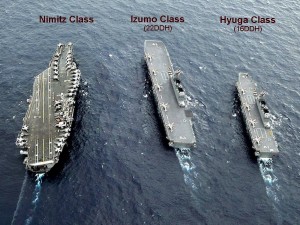
Even as a biased harrier guy, S. Korea buying harriers today to operate off of two mini-LHD’s would be dumb as hell. What’s the point?
Yeah, but you said "weight and logistics" not "DOTMILPF to allow jets to operate from a ship" so I figured you were focusing more on the engineering aspects of the ships themselves. Obviously getting them to a place where they could operate jets is a multi-disciplinary problem that will involve solving several problems; none of which is insurmountable on its own.
I did and I realized that after my response, but still my original point remains that I am wary they have equipped their ships to handle jet aircraft already.
Good article discussing the modifications to this class the Japanese already made.
the potential for operating STOVL aircraft from these vessels is high. For instance, in addition to greater size, major alterations were made to the design of the flight deck from Japan’s previous Hyuga class of helicopter destroyers. The new Izumos remove obstacles from the flight deck and rearrange equipment that would prevent the launch and recovery of fixed-wing aircraft. The CIWS system mounted on the foredeck of the Hyuga class has been moved well to the side, opening up the much needed space necessary for fixed-wing operations. Moreover, the aft vertical launch silo has also been removed, allowing for greater ease of aircraft recovery. By and large, changes such as these are critical for allowing the vessel to operate fixed-wing aircraft....
All good stuff but are the decks and elevators strong enough? Is there enough hangar space? Enough weapons storage space? Frankly I don't know but I certainly haven't seen answers yet and you can't tell by merely looking at the ships, that is an amateur's analysis. That is even before they commit to the HUGE outlay necessary to buy, staff and equip a legitimate carrier jet force. Then they have to figure out what they are actually going to do with them, neither the ROKN or JMSDF is an expeditionary force or aspire to be one which is why countries usually have jet-equipped carriers.
All good stuff but are the decks and elevators strong enough? Is there enough hangar space? Enough weapons storage space? Frankly I don't know but I certainly haven't seen answers yet and you can't tell by merely looking at the ships, that is an amateur's analysis. That is even before they commit to the HUGE outlay necessary to buy, staff and equip a legitimate carrier jet force. Then they have to figure out what they are actually going to do with them, neither the ROKN or JMSDF is an expeditionary force or aspire to be one which is why countries usually have jet-equipped carriers.
Good questions. I don't know, Japan needs SLOC for oil and trade and perhaps they are anticipating trouble with China. But that is why I brought up the Mogami and how the Japanese got around the London Naval Treaty. I would not be surprised if the Izumo class was designed with the JSF in mind. I'm not an engineer - and my multi-variable calculus grades would confirm that - but I wonder how difficult it would be to add a ski-jump on the Izumo and Kaga.
Another ship the size of the Dokdo and Hyuga classes are the original helicopter carriers - the Iwo Jima class LPH's. The first purpose built Gator carriers with room for 25 helos, they were the centerpiece of a 4 ship ARG/MEU, generally working in concert with a LPD, a LSD and a LST.
One thing I did not know but was released in 2012 was that President Reagan offered the Iwo Jima to Great Britain in the event one of their carriers was sunk in the Falklands.
The July 2012 newsletter of the United States Naval Institute, revealed that the Reagan Administration offered the use of the Iwo Jima as a replacement in case either of the two British carriers, the Hermes and Invincible, had been damaged or destroyed during the 1982 Falklands War. This top-secret contingency plan was revealed to the staff of the Naval Institute by John Lehman, the U.S. Secretary of the Navy at the time of the Falklands War, from a speech provided to the Naval Institute that Lehman made in Portsmouth, UK on 26 June 2012. Lehman stated that the loan of the Iwo Jima was made in response to a request from the Royal Navy, and it had the endorsement of U.S. President Ronald Reagan and U.S. Secretary of Defense Caspar Weinberger. The actual planning for the Iwo Jima loan-out was done by the staff of the U.S. Second Fleet under the direction of Vice Admiral James Lyons, who confirmed Lehman's revelations with the Naval Institute staff. Contingency planning envisioned American military contractors, likely retired sailors with knowledge of the Iwo Jima's systems, assisting the British in manning the U.S. helicopter carrier during the loan-out. Naval analyst Eric Wertheim compared this arrangement to the Flying Tigers. Significantly, except for U.S. Secretary of State Alexander Haig, the U.S. Department of State was not included in the loan-out negotiations.
https://en.wikipedia.org/wiki/USS_Iwo_Jima_(LPH-2)
https://news.usni.org/2012/06/27/reagan-readied-us-warship-82-falklands-war-0
Length: 592', Beam: 84', Displacement: 22,000 HP gave 22 knots.
Commissioned: 1961, Decommissioned: 1993
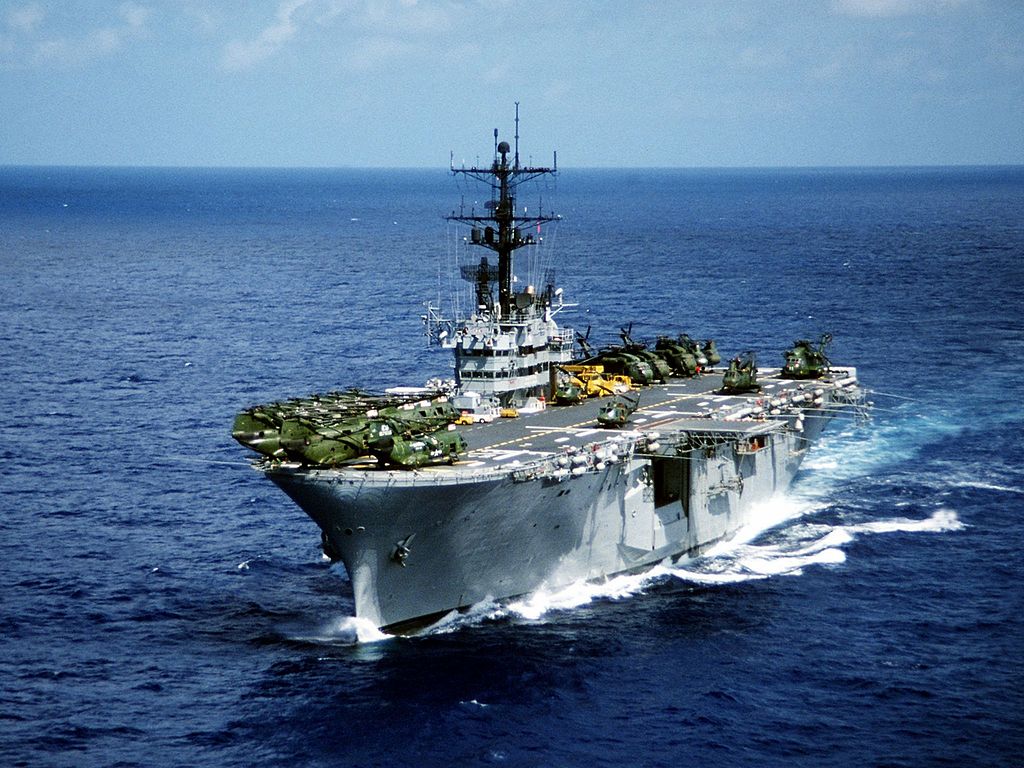
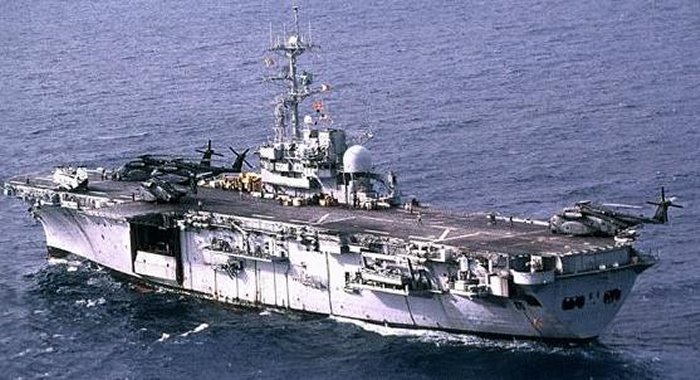
For our Harrier brethren....
And for the Helo bubbas.... (appears to be off of Lebanon in the 1980's)
My point is that none of this needs to have been built in. Essex class carriers weren't built to handle jet aircraft yet they were altered to be able to do so and were able to serve with equipment that their original designers never considered. Same for V-22s and JSFs on LHDs (and I assume CVs). For instance, all of the LHDs will have to get altered to work with JSF; their centerline will need to move a few feet to port and maintenance facilities will need to be upgraded as they were for the V-22. If at some point someone decides that the increased aviation facilities on LHA-6 make more sense then NAVSEA could always alter the LHDs and LHAs with well decks and modify them to a different baseline. Or I'm sure LHA-6 could get a well deck installed if that were deemed worth the cost. Tripoli was also modified when she went from an LPH to an MCS to raise her hangar ceiling height to accommodate MH-53s. Of course she caught on fire not too long after and was decommned but such is life.I did and I realized that after my response, but still my original point remains that I am wary they have equipped their ships to handle jet aircraft already.
All good stuff but are the decks and elevators strong enough? Is there enough hangar space? Enough weapons storage space? Frankly I don't know but I certainly haven't seen answers yet and you can't tell by merely looking at the ships, that is an amateur's analysis. That is even before they commit to the HUGE outlay necessary to buy, staff and equip a legitimate carrier jet force. Then they have to figure out what they are actually going to do with them, neither the ROKN or JMSDF is an expeditionary force or aspire to be one which is why countries usually have jet-equipped carriers.
If the Izumo and Kaga need to be modified I'm sure the JMSDF can figure out how to mod their ships. The hard part is usually coming up with the money but it seems like Abe hasn't had too much trouble finding some scratch for the Japanese Defense Forces. The DOTMLPF portion will also take money and time but that's what people with lots of stars get paid the big bucks for. If this is something the IJN, er, JMSDF wants to do the only thing standing in their way is time, money, and work.
My point is that none of this needs to have been built in. Essex class carriers weren't built to handle jet aircraft yet they were altered to be able to do so and were able to serve with equipment that their original designers never considered. Same for V-22s and JSFs on LHDs (and I assume CVs)....
No, none of it has to be baked into the ship already but they would likely have to be significant modifications that cost a lot of money that may or may not pan out in the end. The SCB-27 modifications to the Essex-class to make them jet-compatible were significant and took two years in the shipyard at a significant cost mainly during the 50's when the DoD was swimming in money. Not only that but the shipyards had significant recent experience in working on carriers having spit out scores of them during WWII.
Modifications to handle V-22's and F-35's on US ships already equipped to handle jets and ~30 aircraft are relatively minor than refitting a ship to handle jets when it wasn't designed as such to start with.
If the Izumo and Kaga need to be modified I'm sure the JMSDF can figure out how to mod their ships. The hard part is usually coming up with the money but it seems like Abe hasn't had too much trouble finding some scratch for the Japanese Defense Forces. The DOTMLPF portion will also take money and time but that's what people with lots of stars get paid the big bucks for. If this is something the IJN, er, JMSDF wants to do the only thing standing in their way is time, money, and work.
I am not saying the ROKN or the JMSDF won't modify their ships to do operate the F-35 or even the Harrier but I think it'll take a lot more modification and money than folks realize, especially the online 'experts' who apparently can asses the aircraft compatibility of a ship just by looking at it, and that is after they make the step of deciding to do so in the first place which for the Japanese especially would be a significant geopolitical decision. Just ask the Brits about their carriers and how much time, political wrangling and money they have taken up so far.
The US Navy may rule the waves - but where the water ends and the ice begins, Ivan has a distinct advantage. With arctic weather bearing down, it seemed like an opportune time to bring up the world's biggest icebreaker: the nuclear powered Arktika due out in 2018. The lead ship of 3 (the others - Sibir and Ural - are due out in 2019 and 2020), it will be the biggest of Russia's 24 ocean going icebreakers, cutting through 13 feet of ice.
Length: 569', Beam: 112', Displacement: 33,540 tons. 2 nuclear reactors give 22 knots - and the ability to break through 13' of ice.
https://en.wikipedia.org/wiki/Arktika_(2016_icebreaker)
Some striking photos at this link. https://sploid.gizmodo.com/stunning-images-of-an-ice-breaker-at-night-in-the-middl-1459486348
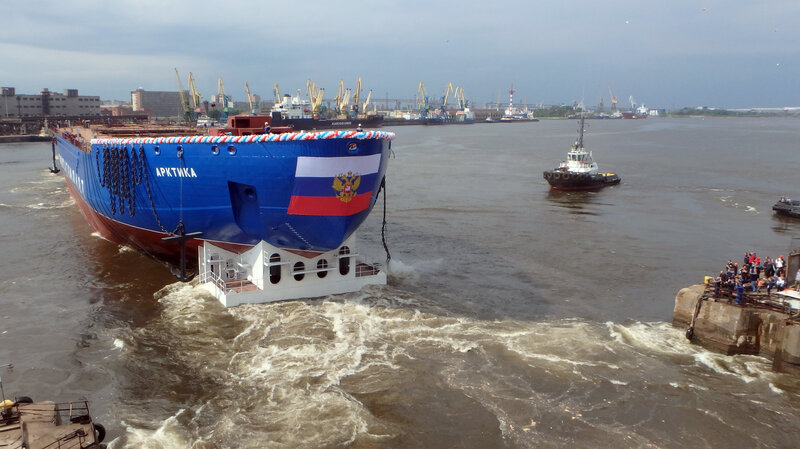
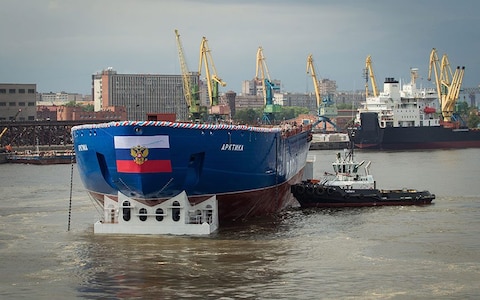
The projected appearance upon completion.

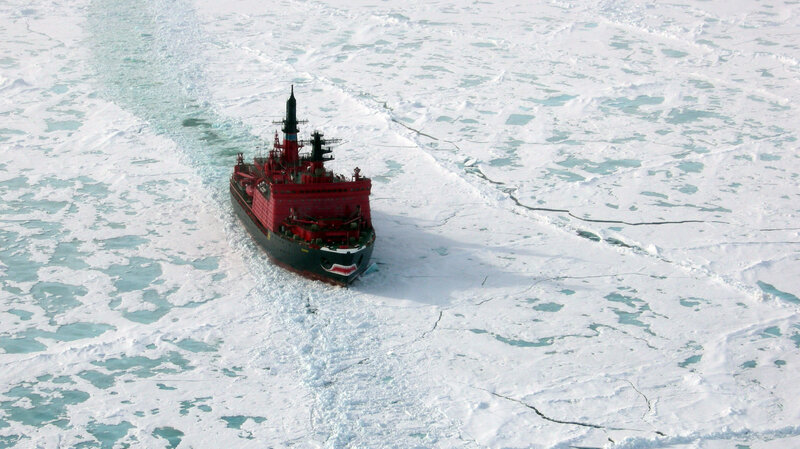
Another Russian nuclear icebreaker, Yamal, travels through the Arctic Ocean on its way to the North Pole in 2007. Russia is the only country with nuclear-powered icebreakers.
Length: 569', Beam: 112', Displacement: 33,540 tons. 2 nuclear reactors give 22 knots - and the ability to break through 13' of ice.
https://en.wikipedia.org/wiki/Arktika_(2016_icebreaker)
Some striking photos at this link. https://sploid.gizmodo.com/stunning-images-of-an-ice-breaker-at-night-in-the-middl-1459486348


The projected appearance upon completion.


Another Russian nuclear icebreaker, Yamal, travels through the Arctic Ocean on its way to the North Pole in 2007. Russia is the only country with nuclear-powered icebreakers.
Who needs ice breakers when you can slip in below the ice?The US Navy may rule the waves - but where the water ends and the ice begins, Ivan has a distinct advantage. With arctic weather bearing down, it seemed like an opportune time to bring up the world's biggest icebreaker: the nuclear powered Arktika due out in 2018. The lead ship of 3 (the others - Sibir and Ural - are due out in 2019 and 2020), it will be the biggest of Russia's 24 ocean going icebreakers, cutting through 13 feet of ice.
Length: 569', Beam: 112', Displacement: 33,540 tons. 2 nuclear reactors give 22 knots - and the ability to break through 13' of ice.
https://en.wikipedia.org/wiki/Arktika_(2016_icebreaker)
Some striking photos at this link. https://sploid.gizmodo.com/stunning-images-of-an-ice-breaker-at-night-in-the-middl-1459486348


The projected appearance upon completion.


Another Russian nuclear icebreaker, Yamal, travels through the Arctic Ocean on its way to the North Pole in 2007. Russia is the only country with nuclear-powered icebreakers.

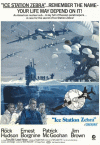
I offer to you the IX-95, USS Echo. She was loaned to the U.S. by New Zealand (reverse lend lease), and was valued for her ability to evade radar and blend in with civilian vessels while observing Japanese movements.. USS Echo logged 40,000 nautical miles while conducting reconnaissance and delivering supplies throughout the Pacific between 1942 and 1944.
For those of you over a certain age, you might recall the ship’s exploits and unusual arrangement of being commanded by a Navy officer at sea and an Army officer in port served as the inspiration for the movie and TV show, “The Wackiest Ship in the Army.”
I understand she is still around as a Museum/Bar....not a bad life.
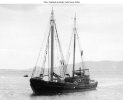
For those of you over a certain age, you might recall the ship’s exploits and unusual arrangement of being commanded by a Navy officer at sea and an Army officer in port served as the inspiration for the movie and TV show, “The Wackiest Ship in the Army.”
I understand she is still around as a Museum/Bar....not a bad life.

USNS Bob Hope (T-AKR-300). Lead ship of 7, this class is a large, medium speed Roll On / Roll Off cargo vessel. The Bob Hope is one of the few ships named for someone still alive at the time.
Length: 951', Beam: 106', Displacement: 62,000 tons. 65,000 HP gives 24 knots. Commissioned in 1997
https://en.wikipedia.org/wiki/USNS_Bob_Hope_(T-AKR-300)
https://www.globalsecurity.org/military/systems/ship/takr-300.htm
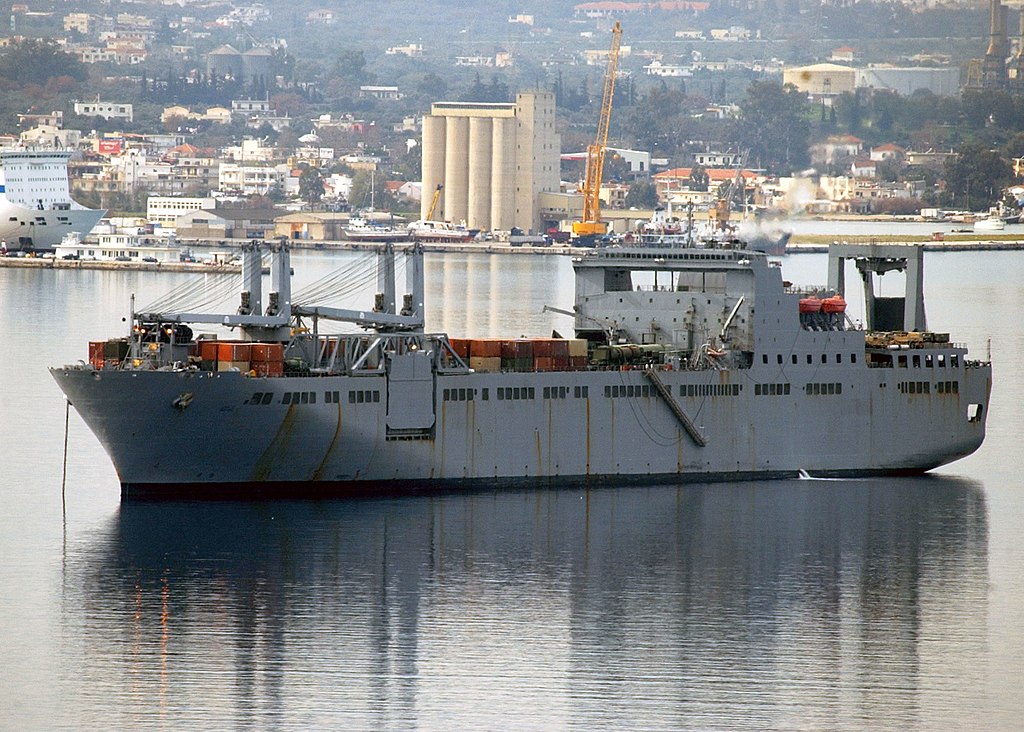
Souda Bay, Crete, Greece (Jan. 20, 2004) -- The Military Sealift Command (MSC) large, medium-speed roll-on/roll-off ship USNS Bob Hope (T-AKR 300) sits at anchorage in Souda harbor during a brief port visit. The 950-foot vessel is named for legendary American entertainer Bob Hope, who tirelessly worked with the United Service Organization (USO) to raise the morale of U.S. troops around the world for more than 50 years.
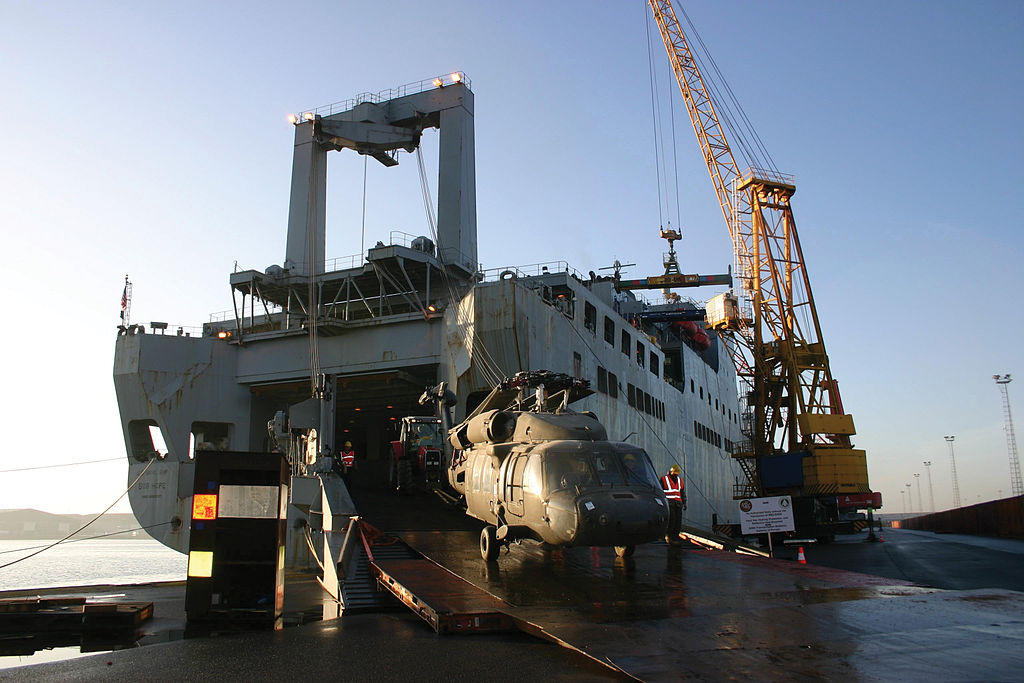
A helicopter being loaded onto Bob Hope in Antwerp, Belgium


Length: 951', Beam: 106', Displacement: 62,000 tons. 65,000 HP gives 24 knots. Commissioned in 1997
https://en.wikipedia.org/wiki/USNS_Bob_Hope_(T-AKR-300)
https://www.globalsecurity.org/military/systems/ship/takr-300.htm

Souda Bay, Crete, Greece (Jan. 20, 2004) -- The Military Sealift Command (MSC) large, medium-speed roll-on/roll-off ship USNS Bob Hope (T-AKR 300) sits at anchorage in Souda harbor during a brief port visit. The 950-foot vessel is named for legendary American entertainer Bob Hope, who tirelessly worked with the United Service Organization (USO) to raise the morale of U.S. troops around the world for more than 50 years.

A helicopter being loaded onto Bob Hope in Antwerp, Belgium


